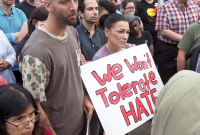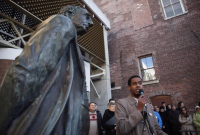Support strong Canadian climate journalism for 2025
A city in central Ontario is calling for the return of an iconic monument to explorer Samuel de Champlain that has been a centrepiece in the city's laid-back waterfront landscape for nearly a century.
Parks Canada, which owns the structure and the land it once sat on, has delayed its return for more than a year as a working group studied what to do in response to complaints about how it portrays Indigenous people.
Orillia city council voted last week to have the monument reconstructed in its original form, but accompanied by something that better reflects both its historical context and current sentiments toward reconciliation.
The city's mayor, Steve Clarke, is hoping Parks Canada sees what he sees — "a wonderful educational opportunity."
"It needs to recognize our whole history, and that is the great and the good, but it's also the bad and the ugly," Clarke said in an interview.
"And I think that's what we'll end up having coming out of this."
Others don't see it that way.
Several dozen people protested on Canada Day at the steps of where the monument stood until it was removed in 2017, calling its depictions of local First Nations people "hurtful" and "racist."
The original monument, conceived around the time of the First World War with the dual aim of marking the arrival in Ontario of European settlers and reconciling differences between French and English Canada, was topped by a statue of the French explorer in full court dress, peering out over nearby Lake Couchiching like a Spanish Conquistador.
Below him on one side were bronze depictions of two Indigenous people looking upwards to a Jesuit priest as they sit at his feet. On the other side were two more Indigenous characters at the feet of a fur trader.
A plaque fixed to the monument states it was "erected to commemorate the advent into Ontario of the white race" under Champlain's leadership.
Parks Canada had the structure torn down and its bronze statues refurbished with an original intent of reconstructing it after an assessment in 2015 determined its foundation and steps were crumbling.
However, the agency had second thoughts about the project after hearing complaints and taking into account the findings of the federal Truth and Reconciliation Commission.
A working group consisting of city, federal, Indigenous and local community representatives held public consultations earlier this year on the future of the monument and is expected to issue a final report within days.
In its draft report to Parks Canada, the group said 70 per cent of people taking part in the consultations were in favour of returning the monument to the park as is, but with and expanded interpretation.
Another 11 per cent supported bringing the monument back — but in a different configuration — while seven per cent said it should not be reinstalled.
Opponents called the monument "offensive," suggested it perpetuated the idea of inequality and said it didn't "accurately reflect the co-operative relationship Champlain had with the Huron-Wendat."
Konrad Sioui, the Huron-Wendat Nation grand chief whose ancestors would have interacted with Champlain, sent a letter to Clarke Thursday, asking Orillia city council to reconsider its decision.
"We're not celebrating Champlain," Sioui said in an interview, noting the French explorer was not a hero to the Huron-Wendat people.
"There's only a few that survived through that era and Champlain used people against people and brought European wars (to) this country."
Parks Canada will have the final say in determining the fate of the monument, parts of which have already been refurbished and are being held in storage, and would not say whether it will be reconstructed. It did, however, restate the government's commitment to address First Nations concerns.
"The government of Canada is committed to reconciliation and renewed relationships with Indigenous Peoples, based on a recognition of rights, respect, co-operation, and partnership," the agency said in a statement emailed Friday.
"Parks Canada is committed to working respectfully with Indigenous Peoples and honouring their contributions to Canada's protected places."
The agency said it has so far spent more that $1.3 million on the project out of a $1.8 million budget.
Environment Minister Catherine McKenna, who holds responsibility for Parks Canada, was not available to comment.
The Champlain bronze, unveiled in 1925 and created by sculptor Vernon March, is just the latest likeness beset by controversy over how some landmarks fit into modern perceptions of historical figures.
In late January of last year, the City of Halifax removed a statue of Edward Cornwallis, who founded the city in 1749. The removal was considered an act of reconciliation over a proclamation Cornwallis had made that offered a bounty to anyone who killed a Mi'kmaw person.
Then, in August, a statue of Sir John A. Macdonald, Canada's first prime minister, was removed from the steps in front of Victoria City Hall, also as a reconciliation gesture over Macdonald's part in creating the country's residential school system.
In the United States, monuments and memorials to Confederate heroes have also been removed, partly driven by the belief that they glorify white supremacy.






Comments
The simplified and glossed accounts of Canada's colonial past are such a staple of the standardized Canadian educational curriculum that questioning its accepted "truths" is only just beginning to make headway. This community, wrestling with a monument that misrepresents both Champlain and the indigenous communities of his times, needs to revisit history and exhume/create a monument that is closer to the truth.
The extensively researched biography of Champlain by David Haskett Fischer entitled "Champlain's Dream" is essential reading for anyone trying to unearth some solid ground beneath the legends and myths. Only then can a monument present something close to reality. Apparently, there are no extant contemporaneous pictorial representations of the man himself and we have only contemporaneous descriptions. This should free the monument's creators to provide greater truth and symbolism for the memory of an extraordinary explorer and, mostly exemplary, nation founder.
That those who followed him, abandoned his dream and reversed his policies should not stain his value to us. Rather we should try to emulate his original intentions.